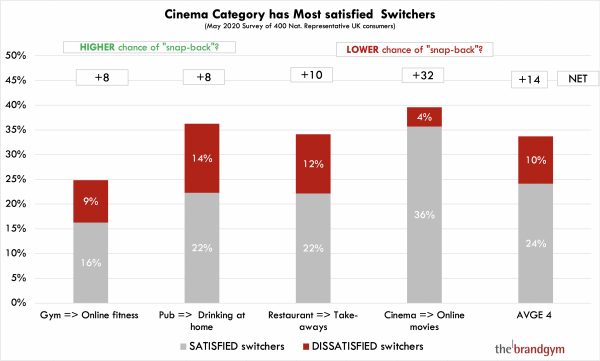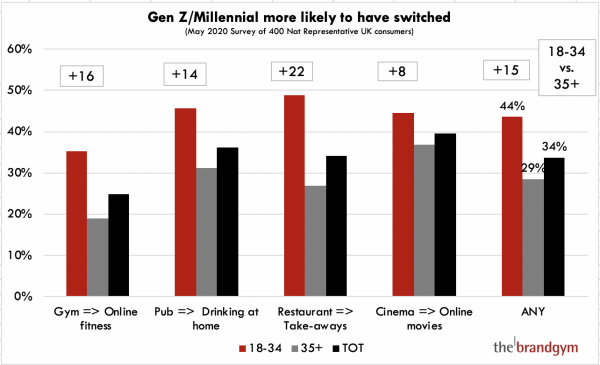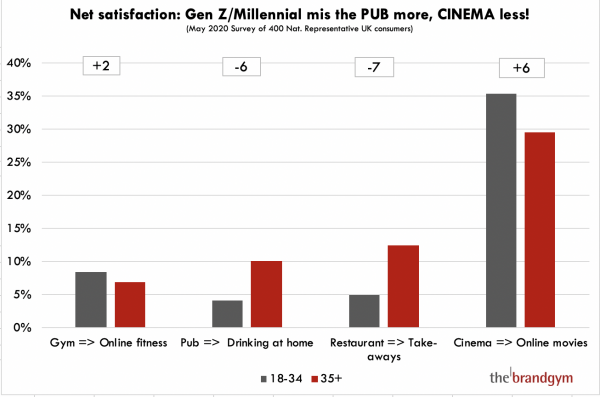Category ‘switches’ during the Covid crisis: which are most satisfying?
“Which categories are more likely to ‘snap back’ to normal post-Covid?” is a question we posed last week, in a post looking at the impact of the Covid crisis on consumer behaviour. In particular, we explored the role of switching (e.g. from going to the cinema to watching more online movies) and satisfaction with these switches. In this post, we share data from a brand new survey* of switches in four different categories to evaluate: i. the degree of switching, ii. the level of satisfaction with the switch:
- Going to the pub => drinking more drinking at home
- Eating out in a restaurant => ordering more take-away food
- Going to the gym => watching more online fitness classes
- Visiting the cinema => watching more online movies
*Nationally representative sample of 400 UK consumers, carried out on 22-23 May, 2020.
1. Turning off the ‘tap’ of supply has driven switching
The instant and radical changes in buying behaviour provoked by the Covid-19 crisis are unprecedented. In particular, we are seeing switches from services where the ‘tap’ of supply has suddenly been turned off to alternatives (e.g. switching from dining out to ordering more take-away food).
A key question we wanted to explore was the level of satisfaction with these switches. We suggest there is more chance of buying behaviour ‘snapping back’ to normal when there are low levels of satisfied switchers. In this case, most people can’t wait to get back to normal. However, bigger numbers of satisfied switchers means more chance of this new behaviour ‘sticking’, given that the lockdown has, in theory, lasted long enough for new behaviours to become habits.
A caveat here is that switching satisfaction is, or course, only part of the story, in some cases a small part. The likelihood of behaviour snapping back depends to a large extent on government responses to the the virus, in terms of social distancing and hygiene requirements. These two massive, complex and costly constraints make bouncing back from this crisis more challenging than any other we’ve lived through. For example, even if millions of us want to jump on a flight to hit the beach this summer, it may be impossible to do this, prohibitively expensive or just too much bloody hassle!
2. Switching and satisfaction varies by category: cinema most at risk?
Looking at switching in the four categories we surveyed, on average 34% of people have switched from an unavailable category to an alternative.
Cinema sticks out as the category with less chance of a snap-back in demand. First, it has the highest number of switchers, with 40% downloading more online movies as a substitute. Even more concerning is a high 32% net satisfaction score (% satisfied – % dissatisfied). This could reflect the significant cost saving versus a trip to the movies and the early online release of some major movies. The challenge for cinema chains, once they can open, will be selling the experiential benefits of a trip to the movies, to get people off their sofas and visiting again. This new data also suggests that film production companies should think carefully before narrowing the ‘window’ between releasing new films at the cinema and then streaming them online.

At the other extreme, switching from gyms to online fitness videos has been lower (25%) and net satisfaction with this switch is also lower (+8pts). Satisfaction of switching from pubs to drinking at home and restaurants to take-away food are also lower. This suggests lots of people are waiting for a chance to go back to the gym or pub! The challenge here will be meeting hygiene and social distancing requirements without cutting capacity below profitable levels.
3. Younger consumers switching more and missing the pub!
Overall, under 35’s are switching more (+15pts), driven by a stringer desire to find alternatives to keeping fit in the gym and eating/drinking out with friends. Online fitness classes and drinking at home can meet functional needs, but lack the social dimensions of gyms and pubs. This suggests younger consumers would a good place to start when encouraging people to start consuming again.

The lack of social interaction from eating and drinking out is also shown in lower levels of net satisfaction with switching for young people in these areas: they are switching more (above) but enjoying this less (below)!
On the other hand, another warning sign for cinemas is that online movie watching is the one switch where under 35s are more satisfied (+6pts). This reflects them being the most experienced in streaming content and perhaps also being more value-conscious, we suggest.

In conclusion, the new data from this survey shows that a large proportion of consumers are switching to find alternatives to categories that have been suddenly cut off. It also confirms the need to understand satisfaction levels with these switches and drivers of satisfaction, to guide the optimum brand response once the crisis lifts.


